By Jeffrey A. Rendall, Images courtesy of Titleist
FAIRHAVEN, MA – “What our R & D team has accomplished with the AP2 714 irons is impressive,” said Steve Pelisek, General Manager, Titleist Golf Clubs.
“They’ve effectively taken each individual iron as its own design and optimized its performance to provide longer and more consistent distance and stopping control, even when you don’t hit a shot perfectly.”
When you think about it, irons are the only golf clubs that usually come in a set. Sure, you can go to a box store and pick up a “set” of metal woods, but if you buy them from a golf shop, they’re more of the custom variety (in terms of loft and shaft). The same is definitely true of sand wedges… and you only need one putter.
But despite the fact that irons come in a set, they’re really individually designed – as Pelisek indicated above. The Titleist AP2 714 irons we tried are no different than most irons in that respect, yet with Titleist, you know they’re going the extra mile to tweak each one.
The 714 Series replaced the AP2 712 Series, which came after the original launches of the AP1 and AP2. It can get a little confusing if you’re not paying attention, but Titleist is building a brand with its irons the way it has with its top-of-the-line golf balls.
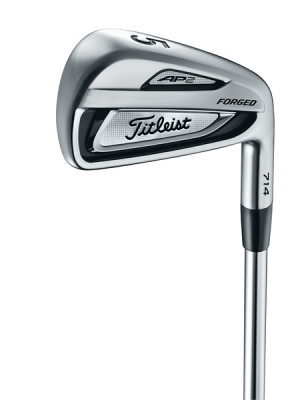 |
The Titleist Pro V1 and Pro V1X have changed several times since first introduction, but the latest versions bear little resemblance to the originals.
It’s the same with the company’s irons. According to Titleist, the AP2 714s deliver longer flight with increased forgiveness and more solid feel than their predecessors. The improvement was accomplished through progressive designs developed by the company’s R & D team to produce optimum launch, trajectory and distance for each loft.
That’s where the specialization comes in. It has to do with moving the Center of Gravity (CG) in each individual iron. In other words, the CG location will be slightly different between a 4-iron and a 5-iron, and quite a bit different than a 9-iron.
Moving around the CG creates higher launching long irons and flatter launching short irons for more carry distance and control. Likewise, the optimized CG heights are positioned closer to the point of impact, resulting in a larger sweet spot for a more solid feel on every shot.
Further, Titleist also utilized innovative tungsten weighting and manufacturing technologies to increase forgiveness in the AP2 714. Technically speaking, performance-engineered profiles with precisely placed high density tungsten weighting in the long and mid irons help produce higher MOI, increasing the speed on mishits to provide consistent distance without sacrificing workability or shot control.
Wow, that was a mouthful.
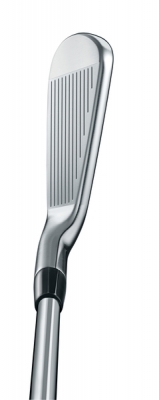 |
The 714’s look nice, too. We’re big fans of classic-looking forged irons and the AP2 714 irons definitely meet the eye test. As just explained, there’s serious engineering in there, too, but you’d have a hard time noticing it at address – and that’s where it counts.
The AP2’s aren’t musclebacks, either. Titleist says the long and mid irons feature improved dual-cavity constructions with high density tungsten efficiently placed low in the head for lower CG. This makes it easier for players to launch the ball higher – again, for more carry.
Similarly, the short irons have a thicker upper face and narrower sole that help raise the CG for a lower, flatter trajectory into the green. Lofts have been strengthened (6-W) by one degree to help lower launch and increase ball speed. Again, more distance.
High density tungsten is placed low in the bottom of the hosel in the P and W irons, which provides for a nice transition into utility wedges, which typically have the CG slightly closer to the heel.
“We’ve really taken progressive design to another level to get that flight and forgiveness where we want it,” Pelisek added. “There isn’t a more progressive set of irons in the industry.”
Strategic tungsten placement also helps with forgiveness. In the long and mid irons, it’s placed low in the toe (and co-forged into the heel) to create high MOI. This hikes up ball speeds across the face for more consistent distance on off-center hits.
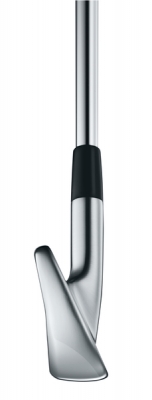 |
Using tungsten – instead of increasing head size – adds forgiveness without making the irons so large that better players would frown on them. Traditional forged irons players like smaller, more concise looks.
Finally, there’s the co-forging process, which was pioneered by Titleist’s engineers.
The company says the tungsten co-forging process takes place in the middle of the AP2’s standard forging process. The partially forged head is removed from the forging die, after which a pilot hole is drilled into the heel. The hole is seeded with the tungsten weight and a steel cap. The head is then returned to the forging die where the tungsten is precisely hammered into place.
“The co-forging process really illustrates the critical thinking and the tremendous design and engineering expertise we have in Titleist R&D to keep finding ways to improve our irons,” said Marni Ines, Director of Titleist Irons Development.
“We have more discretionary weight to play with on the AP2 because of its smaller chassis, which provided us the opportunity to place tungsten in the extreme perimeters of the club head. On average there are over 40 grams of tungsten in the long and mid irons (#3-7), which is around 20 percent of the total head weight. This efficient weighting produces high MOI in a tour-proven profile.”
Instead of the usual 3-PW configuration of the set, we chose 4-W (the “w” is a 50 degree gap wedge). The set came with True Temper Dynamic Gold shafts, which is the stock shaft for the AP2.
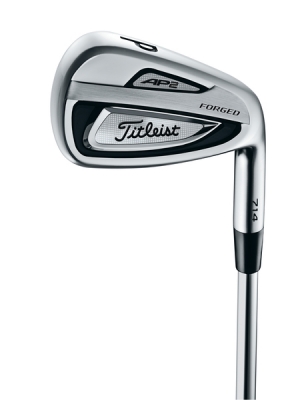 |
The first thing we noticed was how forgiving the irons proved to be -- and that was consistent throughout the set. The AP2 714’s head size was a little larger than some of the forged irons we’ve tried of late, but there wasn’t a lengthy period of visual adjustment.
The high and straight launch was definitely confidence-inspiring.
We didn’t see a big distance boost, however. Having employed some lighter weight steel shafts recently, we figure the “stock” shafts probably weren’t as good of a match. Off-center hits would still fly straight, but would come up short.
We do not scientifically test clubs, so there’s no way of knowing for sure what’s happening from a launch standpoint. We were able to overcome differences in distance simply by adding an extra club. The forgiving nature of the clubs was good enough on its own to suggest that these irons are “keepers.”
We certainly would recommend that you try the AP2 714’s along with other top-of-the-line irons if you’re in the market for traditional forged irons. You know with Titleist, you’re guaranteed that quality and engineering are built-in.
A few words on the Titleist 913 D3 driver
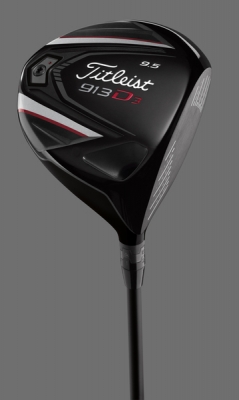 |
The buzz in the golf world concerns the release of Titleist’s latest drivers, the 915 series, but we also had a chance to look at the 913 D3 driver recently.
When they were released, Titleist touted the 913s as the fastest, most consistent drivers the company had ever designed, delivering maximum ball speeds over a large area of the face.
"The 913D2 and 913D3 drivers offer the highest performance of any adjustable drivers on the market, particularly when it comes to speed and forgiveness," said Dan Stone, Vice President of Research and Development, Titleist Golf Clubs. “Every serious golfer, from tour players to amateurs of all skill levels, will experience more distance potential and better driving performance with 913.”
“Golfers can choose their 913 model based on size or shape preference, amount of forgiveness or workability, and amount of draw bias,” said Stone. “They can then dial-in their launch and spin settings precisely using the SureFit Tour hosel.”
Driver adjustability’s been the rage since TaylorMade introduced it about a decade ago. Most adjustable drivers come with a similar adjustability platform these days and Titleist’s 913 is no different.
We dialed in a little more loft and left the face at neutral, trying out a couple different positions. Without prolonged use or a launch monitor, it’s very difficult to tell how much a setting helps – or hurts -- performance.
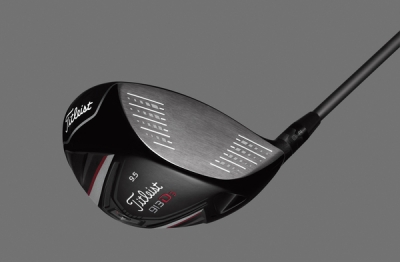 |
We will say, the 913 D3 driver is extremely “user friendly” in the traditional golf sense – so much so that it’s going to be interesting to see how Titleist would go one-up on it with the 915 drivers.
Simply put, the 913 D3 is long and very straight. We very much enjoyed the 910 (913’s predecessor) as well, though the 913 gave us a little more roll-out – and hence, more distance.
A local golf pro described the 913 as the “most accurate driver on the market.” We certainly agree. Whatever Titleist did, in terms of reducing sidespin, seems to work. Add in comparable distance to other high-end drivers, and you’ve got a good combination.
It’s also adjustable enough to fine-tune it for players who tee it up regularly.
In other words, the 913’s a real winner. The 913 will likely continue to be available with high-end golf retailers for some time (at very reasonable prices), worth checking out in comparison to all the newer drivers on the market.
Details:
Titleist AP2 714 Irons
Available at higher end golf retailers near you.
STOCK SHAFT: High performance, tour-proven Dynamic Gold steel shaft provides tour-preferred flight, feel, feedback and performance.
For more information on the latest Titleist products, check out the company’s website: http://www.titleist.com/
| Related Links | Comments on this article? | |
|
Maryland National Golf Club Hollow Creek Golf Club Rocky Gap Resort PB Dye Golf Club in Ijamsville Whiskey Creek Golf Club |
E-mail Jeff Rendall, Editor: jrendall@golftheunitedstates.com |












